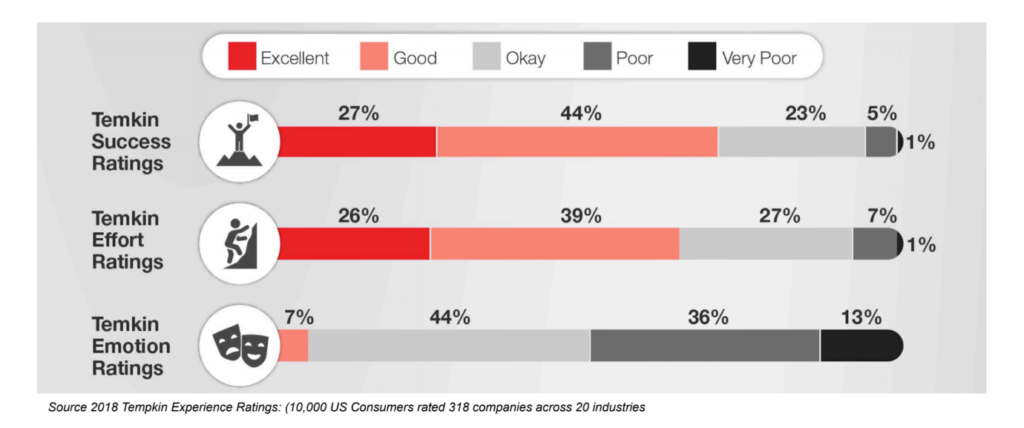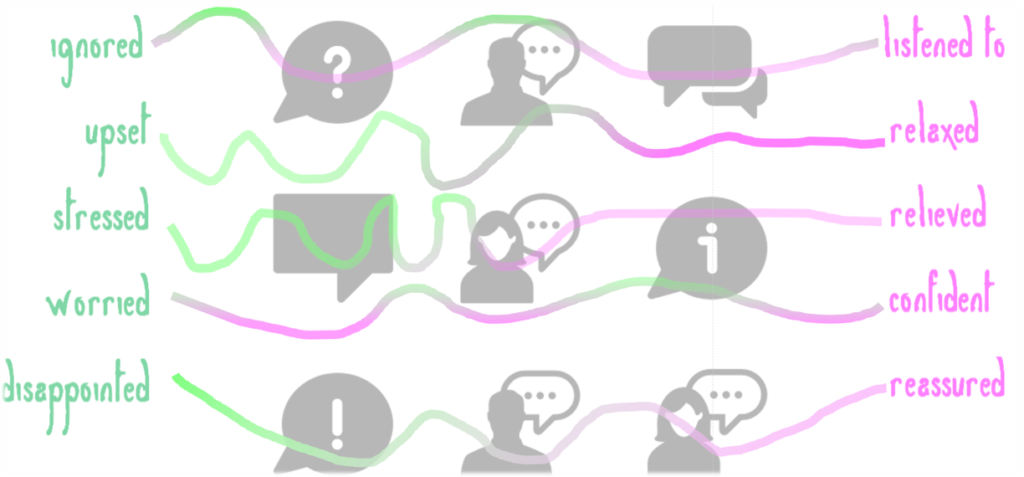
Something I wrote for Enghouse Interactive
If customer experience management is about anything, it could be described as a determined effort to follow through on the brand promise. In other words, making sure customer outcomes match their expectations which are influenced by the way a brand promotes itself and appears to its audiences. Ideally, customer experience and brand promise are one.
However ongoing research from Bruce Temkin, now head of XM at Qualtrics, shows that organisations lack a balanced agenda in experience management. Of the three components making up a customer experience, considerable progress has been made regarding success/outcomes and reducing customer effort getting there. The neglected area is emotive. How customers feel. Yet behavioural psychologists tell us emotion trumps reason more often than not in consumer decision making.

To my mind, it is a neglected area in terms of organisational competency. In my experience, this is as true for CX teams designing end to end journeys as for downstream customer service teams picking up the tab when things don’t go according to plan.
Emotion matters
When customers leave brands, price is often quoted. Dig a little deeper and how they were treated often explains why they really left.
Looking further into the role of emotion, we learn that every interaction impacts our relationship with a brand over time. Negative emotive outcomes make us feel less likely to re-engage with a brand. Positive ones bind us closer. Therefore, every time we call or message for help, the service organisation is either subtracting or adding to our long term value.
There comes a point when the cumulative impact of negative experiences kicks in. Research on declining loyalty levels and why customers walk away from brands show customers expect more and forgive less. Sometimes customers will quit even a well-loved brand after just one poor service experience. Avoidable attrition must be a priority. Especially in recessionary times and reduced budgets.
Yet few service organisations approach customer outcomes in terms of tracking emotive states. Or bother to correlate how a customer ends up remembering a service event against their propensity to buy, their ongoing lifetime value or willingness to trust, forgive or advocate.
Psychologist Daniel Kahneman offers some important insights in the way memory works. He distinguishes between the experiencing self and the remembering self. Put simply, our brains discard the majority of our moment by moment experience. What we end up committing to memory becomes what we then believe was the actual experience.
This summarised view is weighted in certain ways.
Given our brain’s mandate is to keep us out of harm’s way, anything that threatens tends to be noticed and retained for future reference. Hence negative thoughts and feelings are prioritised for retention.
Secondly, our brains form memories from the highlights of an event. Kahneman calls this system one processing (the fast version – running on heuristics and habit). Outliers and endings provide the summary. It is why season finales are designed as such peak points of drama. They become a shortcut for our assessment of the entire series.
This psychology is used in emotive CX for customer interaction. How can we influence what is remembered? Emotive outcomes matter as much as functional ones. Both need to be successfully delivered. So, we use a unified management process to train, track and improve how each interaction ends. The mission is to deliver an appropriately positive outcome every time.

I’ve been running planning sessions with groups of early adopter brands for the last two years. Given the accelerated drive for getting things done since the pandemic turned life upside down, I’ve reinvented how the programme works so that a pilot can be activated within 6 weeks as opposed to six months. Details are here.
During that time, I’ve learnt to articulate why this approach matters and its value to service organisations.
- Emotion remains an unappreciated element in customer experience management despite its role in customer loyalty. Contact centres are a crucial touchpoint and need a leadership led approach beyond hoping for enough empathy in customer-facing teams.
- Emotive CX has a commercial impact. There is clear ROI. This needs organised management.
- In anxious times more of us are conscious of our emotive state. Mental health issues are only rising through the unpredictability of new lockdowns, health concerns and the financial risks many are facing as furlough ends and organisations look to save costs. Organisations must rise to this challenge and meet people’s emotive needs.
- AI and automation are being fast-tracked to help enable digital-first agendas. As it removes significant volumes of simple enquiries, there will be a growing opportunity to refocus live assistance on the emotive and complex. This requires new capability and support.
On a final note, I’ve noticed how often empathy is now being discussed as a much needed organizational ability. I agree. However, the ability to imagine how another person feels is only half the story. Attending to someone’s emotive needs implies an outcome.
The question remains how well are you organised to achieve that?




